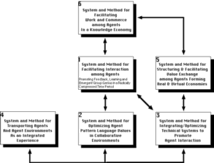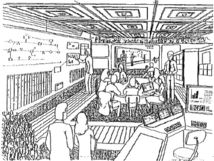c o n f i d e n t i a l
Privileged access only
This is a Hypertext version of the Patent Pending
by iterations of the Taylor System and Method
SYSTEM AND METHOD FOR AUGMENTING KNOWLEDGE COMMERCE
Subsystem 6 Summary
System and Method for Facilitating Work and Commerce among Agents in a Knowledge Economy
Overview of the Patent Application
In accordance with another aspect of the present invention, it is possible to develop a model for a total service network that takes insights and ideas from the creation stage to the organizational stage -- an Intellectual Capital Factory. In direct contrast to the conventional approach of trying to quantify that which occurs or is found to exist in "successful" organizations, makes it possible to manage and grow intellectual capital from the seed of a good idea. The contrast between these two approaches is as sharp as the contrast between foraging for food in a fertile valley and hydroponic agriculture. Thus, where a conventional view of intellectual capital management might focus on retaining employees that demonstrate creativity, the present invention provides and maintains a work environment that unleashes the creativity that most people have so that "ordinary" individuals achieve the "extraordinary" results that they are capable of. This Sub-System is really a high level system that combines two things while tying all the rest together. The two things are the PatchWorks Design (tm) Process and the Intellectual Capital Process The key to bringing structure to the process of creating intellectual capital may be summarized in the model of an intellectual capital factory or "IC factory." The IC factory is a model for bringing structure to creation, nurturing and protection of intellectual capital. A central premise of this model is the notion that the creative process cannot be controlled, but it can be managed. The creative process is managed by managing the conditions that create or block creativity. Thus it is necessary to manage the process of information development within a group and manage the process of information development within a group and to manage the energy field around the group. All of this is accomplished through structure that can be managed and modeled as an IC Factory. The IC factory model provides a system and method for creating and nurturing intellectual capital. Again, information age products are not capital intensive. Information age products are difficult to create, but easy to recreate or replicate. This is because knowledge-based products result from an insight or idea. Once the insight or idea is recognized a path to creation of the knowledge-based product may be inevitable at least once that path is made clear in the introduction of a product. Thus, for example, knowledge-based products such as computer software are often based on important insight, but once a product becomes available, the product itself can be easily replicated or the insight can be appropriated by others. There are also examples in the life sciences field. For example, the discovery of a new composition, pharmaceutical or gene sequence requires a great deal of research and in some instances an insight. However, once the existence of the composition, pharmaceutical or gene sequence is understood it is easily, in a relative sense , replicated The IC factory model represents a structured non-linear non-incremental approach to creating, nurturing and protecting intellectual capital. In this sense, the IC factory structured approach is analogous to hydroponic growth of ideas. The IC factory requires a knowledge-based (body of knowledge) and systems (educational and technical) for keeping the knowledge-based fresh and current. In addition, there must be systems for facilitating access to the knowledge-based within work groups. Thus, one critical function that must occur within the IC factory is growing and adapting the body of knowledge required to model the internal and external environment. This is done, as mentioned before, by creating education systems to receive inputs from external services -- find out whats going on and use technical systems to leverage education systems and adapt a body of knowledge. When these systems are appropriately structured to achieve these functions, ideas are introduced into the system (the IC factory) and rapidly iterated and grown. The IC factory also includes a structured environment that allows release of group genius. This requires careful attention to the effect of ones environment on ones creativity and productivity. The environments of the present invention are a good example of this type of structured environment, but most current work environments include numerous obstacles to creativity and group genius. One of the critical elements of any collaborative work environment is to create an environment that allows individuals and groups to see the whole picture and, simultaneously, see details to allow effective collaboration. In addition, to release group genius, there must be a way to facilitate the process of decision making. We have found that an interdisciplinary approach is particularly helpful. Thus, it is very important to have all stakeholders involved. In the case of a IC factory, the stakeholders would certainly include an expert in intellectual property, an expert in capital financing, and an expert in the particular industry that our idea relates to. The IC factory also includes a ValueWeb that is managed as a venture. The web members provide inputs into the system or venture, but also have separate identities. In this sense, the members of the value web are like software objects (agents) and that they bring value to the web and draw value from the web. Examples of web members within an IC factory would include the intellectual property expert member and the capital financing expert member or object. The members or objects can be individuals or groups of individuals or firms. Obviously, a critical aspect of managing a web of independent agents is the integration and system facilitation function - the Systems Integrator (ToA). The value of members provide feedback loops into areas of interest so as to keep the knowledge base fresh and current. The IC factory may be industry focused or generalist depending on the available expert objects. As mentioned above, the IC factory requires a system integrator who bring these various elements together. This is best done using a system and method for facilitating interaction of intelligent agents. In this regard, it should be understood that the agents could be human agents, organizational agents, machine agents and electronic agents. The present invention achieves hydroponic growth of ideas by removing environmental and structural barriers and expanding an organizations knowledge base. The IC factory approach provides a clear path to directly (not indirectly) proving every element of intellectual capital in a systematic way. Thus, all the traditional components of intellectual capital are proved in a systematic way. Consider, for example, the improvements to corporate brain power, organizational knowledge, customer relations, the ability to innovate, employee morale, the knowledge base, the technology base and the market position. Successful high technology companies empirically know that environment profoundly effects morale. Thus, the emergence of "open work places and casual dress" has been a characteristic feature of emerging growth companies. However, these approaches are working on the edges, but not addressing the environment in a comprehensive way. In summary, therefore, the IC factory is an open system that incorporate new technologies or individuals for performing the critical functions. Ultimately, the quality of results achieved by the IC factory model will depend on the quality of performing the requisite functions. The critical functions may be summarized as follows: (1) Establishing a knowledge base 1that is continuously refreshed with inputs from outside the organization (IC factory). In the case of an IC factory, the knowledge base must include information concerning intellectual property, a venture capital financing and the particular industry involved. (2) The information and the knowledge base must be made available to all people that need the information in the collaborative process by systematic application of the 10 Step Process. (3) Environmental barriers to collaboration and communication must be removed. (4) The output of the IC factory must be protectable so as to establish "ownership" of the value created. The basic team members of an IC factory are selected to achieve the following functions: 1. Intellectual Property: This cannot be addressed after the fact. It must be part o the process of creating product. 2. Incubation: Providing the tangible resources to develop a product and create a product or service. 3. Organizational Building Capacity 4. Financing 5. Operational Capabilities 6. Marketing and Distribution Systems and, perhaps the most important, a system integrative for integrating each of these six other functions. Finally, and most importantly, there must be a system integrator or facilitator. Intellectual capital involves the interaction among agents. This includes human-human interaction; human to environment interaction; human to machine interaction; and machine to machine interaction. To date, there has been no system and method for facilitating interaction among these various agents. As a result, there is no reliable direct process for moving an idea to a sustainable organization. Communication within the organization is critical to establish dynamic, adaptable self-adjusting organic organization that operates with feedback loops to insure rapid iteration and growth to achieve the desired hydroponic growth of ideas. The IC factory model provides such a process for turning ideas into protectable intellectual capital. Each of the Sub-Systems of the present invention provide distinct and independently valuable results that contribute to addressing the paradoxes and problems associated with the Knowledge Economy, and the transition to it, as described below.
Access to this site is restricted to the following groups:
MG Taylor Corporation Core Staff
MG Taylor Corporation Board and Advisors
MG Taylor Corporation Legal Team
AI Core Staff
KnOwhere Stores Core Staff
Yolke Core team
iterations
CAMELOT KreW
BDO Evaluation Team
MGT Core ValueWeb Team
Alacrity Ventures
HP Star Team
If you are not a member of these groups and received your passwork from Matt Taylor or your team leader, you are violating the privacy of iterations and MG Taylor
- unauthorized access WILL BE PROSECUTED -
Contact:
Matt Taylor 843 671 4755
posted June 1, 2000
revised June 1, 2000
• 20000601.142050.mt •
(note: this document is about 5% finished)
Copyright© 1982, 1997, 1998, 1999, 2000 Matt Taylor

